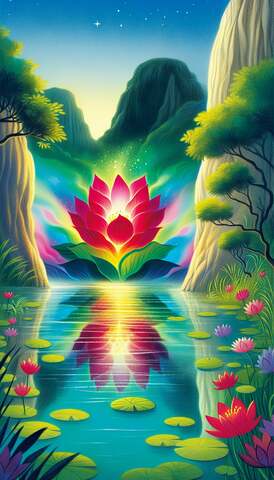
在很久以前,有一个著名的文学家叫江淹。
他写了一篇非常美的文章,叫做《丽色赋》。
这篇文章是描述一位美丽的女子的。
江淹说,这位美丽的女子就像一朵生长在平静如镜的池塘里的红莲花。
当她稍微动一下,就像一片绚丽多彩的云彩从山崖间飘出来一样。
她的色彩鲜艳、灿烂耀眼。
这篇《丽色赋》写的真是太美了!
它把美女的美丽和风姿生动地展现了出来。
你知道吗?
这种文体叫做“赋”。
赋是一种介于诗歌和散文之间的传统文学体裁,既像散文那样自由流畅,又带有诗歌的韵律和节奏。
赋在汉魏六朝的时候非常流行。
而我们今天要讲的成语“五光十色”,就是从这个“赋”中演变出来的。
它用来形容景色鲜艳富丽,光彩夺目。
也可以用来比喻事物的内容丰富,变化万千。
所以,当我们说一个地方或者一件东西“五光十色”的时候,就是在赞美它们非常美丽,非常丰富多彩。
A long, long time ago, there was a famous writer named James.
He wrote a very beautiful article called 'The Rhapsody of Beauty'.
This article described a beautiful woman.
James said that this beautiful woman was like a red lotus growing in a calm pond as clear as a mirror.
When she moved slightly, it was like a dazzling multi-colored cloud floating out from between the cliffs.
Her colors were bright and dazzling.
'The Rhapsody of Beauty' was written so beautifully!
It vividly portrayed the beauty and grace of the beauty.
Do you know?
This style is called 'Rhapsody'.
Rhapsody is a traditional literary genre between poetry and prose, free-flowing like prose, but also with the rhythm and rhyme of poetry.
Rhapsodies were very popular during the Han, Wei, and Six Dynasties.
And the idiom we're talking about today, 'Radiant and Colorful', evolved from this 'Rhapsody'.
It's used to describe a scene that is rich and resplendent, dazzling to the eye.
It can also be used to比喻 things that are rich in content and varied.
So, when we say a place or a thing is 'Radiant and Colorful', we're praising them for being very beautiful and full of variety.